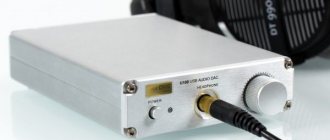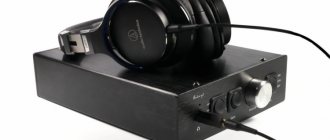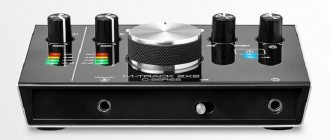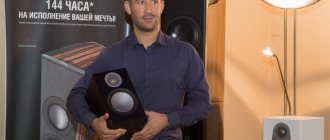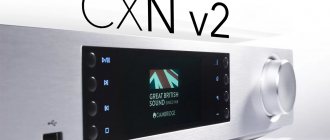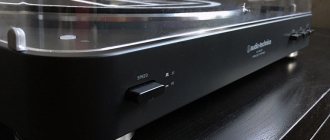External DAC Atoll DAC 200, review.
“Alain Delon, Alain Delon, speaks French..” (“Nautilus Pompilius” quote from the song)
In the last month of the year, we had a great opportunity to test the new Dac 200 Atoll.
Let's start with an idea of its functionality:
The Dac 200 has a standard format (44cm wide) and the same height as the previous Dac 100 model. The device has function buttons on the front panel for input selection and a volume potentiometer, this information about the selected input and volume level is easy to read on the digital display.
So, we have 8 inputs (1 AES, 2 coaxial, 3 optical, 1 USB asynchronous, 1 wireless), 2 digital outputs (coaxial and Toslink), 2 analog outputs (1 RCA and 1 XLR), as well as a headphone output.
All digital inputs provide 24bit/192khz, except wireless (16/44). The latter allows you to connect the DAC directly to a Windows or APPLE computer using a Wireless USB Dongle.
There was no dongle in our kit, so we are not considering this connection option, despite the Wi-Fi origin of this thing, it is a “thing in itself,” that is, we cannot do without it.
The company provides for the use of a dongle purchased from it separately; the red button on the back of the device is used to bind it.
When you press the wireless input button on the front panel, the display indicates - (A – P...), that is, the device is searching for a dongle, binding is performed with the (ASSOC) button.
Listening leaves no doubt - this is a good Atoll! In terms of sound, it has advanced further than its brother Dac 100. When comparing the two products, you can find that the sound quality is very high, although subjectively different. This is good news, especially for fans of this brand - it means Atoll is not standing still in its developments, but is demonstrating real know-how in digital-to-analog conversion at a much higher level than before. We would note that in the new DAC, the company successfully combines the traditional quality of the now classic solution based on Burr Brown 1792 and the interfaces necessary for the modern audiophile. The USB Audio 2.0 profile allows you to use modes up to 24/192 when connecting the DAC 200 to Windows or Apple computers, which is what is actually required for playing back high-resolution recordings.
This profile is supported natively on Apple computers; on Windows you need to install the drivers, taking them from the manufacturer’s website. The undoubted advantage of the DAC 200 is its well-thought-out circuit design, for example: the use of MKP capacitors in the output stage, separate transformers in the discrete and analog parts, and an effective voltage stabilization system that prevents interference between circuits.
As a result, the user has high quality sound reproduction for all options for including the device in a system with various sources and amplifiers, and works well as a headphone amplifier.
Atoll 200 raises, so to speak, a budget CD turntable to a serious level, both in terms of optics and coaxial, we also add here stable operation and simplicity and ease of operation.
In conclusion, we note that if you do not dive into the subjective terminology of impressions, such as “warm sound, very wide stage...”, then being familiar with various DACs, the 200th Atoll, unlike some competitors, attracts attention with its impeccable transmission of the “middle” and “upper” frequencies, we are no longer talking about bass, since a competent reader most likely knows that most branded ducks are already in order with this - remember Kotelnikov’s theorem!
Sincerely,
Description
The Atoll DAC 200 Signature external digital-to-analog converter is equipped with a high-quality eight-channel ESS SABER ES9028PRO converter chip that supports PCM formats up to 32 bit/768 kHz and DSD (up to DSD512). The chip provides a fairly high dynamic range and is characterized by a low harmonic distortion coefficient. The model is equipped with a precision clock generator that guarantees low jitter levels. There is also a low-noise ESS SABER ES9311EQ LDO regulator on board, which stabilizes the voltage.
The external DAC has balanced circuitry, twelve independent voltage regulators and uses two power linear transformers that supply power to the output stages. Discrete output stages do not use feedback, i.e. They operate in Class A to reduce distortion and provide precise, clear sound. Atoll DAC 200 Signature circuits feature carefully selected, high-quality components, including silver plated mica capacitors and high-tech MKP capacitors.
The all-metal full-size case of the Atoll DAC 200 Signature is low in height and has a carefully crafted aluminum front panel with rounded corners. It is possible to adjust the volume level using a standard universal remote control or a two-button regulator located on the facade (a switchable function), that is, this digital-to-analog converter can be connected directly to the terminal. In addition, there is access to control the DAC filters. A low-power OLED display is integrated into the center of the case façade, displaying the volume level, the selected source and the sampling rate of the received audio file.
The front panel of the Atoll DAC 200 Signature has a 3.5 mm output from a built-in high-quality headphone amplifier.
There is a Bluetooth receiver on board. The model boasts a wide range of optical and coaxial inputs. There is a balanced digital input AES/EBU, as well as asynchronous USB, which makes it possible to receive signals in PCM (32 bit/768 kHz) and DSD512 formats. There are optical and coaxial output connectors, and the analog section is represented by RCA and XLR outputs. Peculiarities
- 8-channel DAC ESS SABER ES9028PRO, built-in Bluetooth receiver
- Precision clock generator with low jitter, variable volume control
- Two line transformers to power the discrete output section operating in class A
- Asynchronous USB port supporting DSD512 and PCM with 32-bit/768 kHz resolution
Characteristics
| DAC | ESS SABER ES9028PRO |
| LDO regulator for voltage stabilization | ESS SABER ES9311EQ |
| Dynamic range | 133 dB |
| Harmonic Distortion (THD+N) | — 120 dB |
| Bluetooth receiver | There is |
| Inputs | 3 Coaxial (up to 24 bit/192 kHz), 3 Optical (up to 24 bit/192 kHz), AES/EBU Balanced (up to 24 bit/192 kHz), USB Asynchronous Type B (up to 32 bit/768 kHz, DSD64/128/256/512) |
| Exits | unbalanced RCA, balanced XLR, coaxial, optical, 3.5 mm headphone |
| Two power transformers for the output section | Yes |
| Remote control | universal |
| Dimensions (WxHxD) | 440x60x280 mm |
| Weight | 4 kg |
DAC-200TS Review AVReport.ru, May 2016
Cary Audio Design was founded in 1989, named after the city in North Carolina where its first production was established. The release of the company's first products - High-End class tube amplifiers - successfully coincided with the global renaissance of tube audio equipment. Cary Audio amplifiers quickly gained popularity among music lovers, and the company received the honorary status of the main manufacturer of tube audio equipment in the States. Over time, Cary Audio has proven that it lives on more than just memories of the audio industry's golden era; Its renowned tube products have been joined by transistorized devices, digital sources, and multi-channel home theater components. But to this day, the combination of modern technology and tube remains the highlight of Cary Audio, and the new DAC-200ts digital-to-analog converter is a clear example of this. The device has several features, among which the DiO (Dual Independent Output) output stage stands out - two independent circuits, one of which is made with transistors, and the other is made with vacuum tubes. Cary Audio DAC-200ts is a large AV rack DAC with 6 digital inputs and a balanced analog output circuit. The DAC-200ts is a large representative of its kind. Compared to numerous devices of the desktop form factor, the Cary Audio DAC is distinguished by its large size and solid weight (12.7 kg). The brushed aluminum front panel is 1 cm thick. In the center of the facade there is a large digital display, under which there are buttons in a long row that switch inputs and modes of the device. The rear panel of the device is rich in a variety of connectors: 5 digital inputs (USB, optical Toslink, two coaxial RCA, AES/EBU with XLR jack), 2 digital outputs (coaxial RCA and Toslink), 2 analog outputs (RCA and balanced XLR). Thanks to two BNC connectors, the device can be used as a clock generator for another digital source or, conversely, receive clock pulses from an external generator, achieving perfect synchronization during data transport. A built-in Wi-Fi module with an antenna and an Ethernet network port allow you to integrate the device into your home network and control it remotely, for example, using your favorite smartphone or tablet. Special applications are already available for the iOS and Android operating systems. The second antenna belongs to the Bluetooth module - this is the sixth digital input of the DAC-200ts, supporting the improved AptX audio decoder. There are only a few service inputs left to mention: trigger and external infrared sensor connectors, as well as a micro-USB socket for firmware updates. Inside, the device body is divided into three compartments. Inside, the DAC-200ts body is divided into three compartments. Dividing the housing using metal bulkheads eliminates electromagnetic interference from one part of the circuit to another. One compartment houses custom power supply transformers equipped with R-Core cores. The central compartment is reserved for input boards, digital processor and power supply circuits. The third compartment contains a common board with digital-to-analog conversion circuits and analog outputs. separate transformers for the digital and analog sections of the circuit. Data reception via USB is carried out by the XMOS xCore microcontroller. Transport is asynchronous, supporting PCM formats up to 32 bit/384 kHz and DSD 64/128/256. The driver for Windows operating systems can be downloaded from the Cary Audio website. Signals from digital inputs other than USB can be upsampled by TruBit, with the user free to select the appropriate sampling rate. For signals with a sampling frequency that is a multiple of 44.1 kHz, upsampling can be increased to 705.6 kHz, for signals that are multiples of 48 kHz - up to 768 kHz. Of course, a number of intermediate sampling rates are allowed: 88.2, 96, 176.4, 192, 352.8/384. The resampling process is carried out by a dedicated DSP processor, increasing the data bit depth to 32 bits. Regardless of whether the user uses the TruBit program or leaves the signal unchanged, the built-in clock generator restores the clock frequency (OSO - Onboard Signal Origination technology). Resynchronizing and buffering data in the DAC-200ts processor radically reduces jitter, reducing it to undetectable values. input and digital processor boards power supply board The fully balanced architecture of the device begins with a digital-to-analog converter circuit that parallels four 2-channel Asahi Kasei AK4490EQ chips, and then continues into the DiO output stage. With two independent output stages, the DAC-200ts becomes a godsend for music connoisseurs: two sound sources in one device, with different sound characteristics, and a huge field for experimentation. And if you also remember about the different options for “upsampling”! The tube output is built around Electro-Harmonix's 12AU7A dual triodes, and the transistor output uses dual Burr-Brown OPA2604 op-amps. symmetrical 4-chip DAC circuit AK4490EQ balanced analogue output DiO: operational amplifiers/tubes 12AU7A DAC-200ts can work as a digital preamplifier. In Master Volume mode, the output signal level is adjusted using the buttons on the remote control (maximum level is 3 V). In Independent Volume mode, the output volume is fixed, but the device independently remembers the level of each input. The long, full-featured remote control that comes with the device is not only related to the digital-to-analog converter, it has sections of buttons for controlling Cary Audio turntables and amplifiers. Remote control Impression Among modern high-end DACs, a very common approach is the analytical, extremely informative nature of playback, which each manufacturer tries to solve within the framework of its budget and the elements of the digital-to-analog conversion circuit used. It is curious that Cary Audio, apparently relying on extensive experience in creating audio components for music lovers, does not pursue super-indicators: super-detailed sound, hyper-scale and holographic image of the music scene, so that every beat is shown in all its glory. But when listening to the Cary Audio DAC-200ts, you literally immediately understand that the sound is balanced, harmonious, everything is in place and there is enough of everything... both details, space, and the temperament of the performance. But in any system, along with elegant musicality, the signature Cary Audio signature is felt. The absolute neutrality of playback is shifted to a light warm zone, giving the sound more comfort and emotional richness. Midrange tones are rendered with exquisite detail, but without being overly nuanced where fine details become distracting. I really liked the deep and prominent bass range. The top is transparent, well-developed, served in a calm manner with a slight haze and some softening of the sharp moments. As we have already said, the scale of the music scene does not acquire a gigantic scope, but the DAC perfectly shows the “air” between the performers, clearly separating them from each other. Excellent rendering of images, in principle, is preserved throughout the entire volume, not limited only to close-ups. The DAC lightly highlights the soloists, without disrupting the correctness of the original composition and subjectively showing even better the echelon of the stage. The transistor and tube parts of the DiO output stage are completely independent and equal in design. Although, it seems to us, the transistor output of the DAC-200ts will be more versatile in terms of playing different musical genres and compatibility with other components of the audio system. The impressions given above about the operation of the DAC apply specifically to the transistor output. What difference does switching to a tube stage make? There are no surprises, the reproduction takes on the typical features of “tube” sound: analog smoothness, beautiful focus on mid-frequency images and a romantic sensuality of music presentation. The soloists move forward and are shown with a special charm, while less attention is paid to distant plans, where the contrast of the picture is worse. Well, the attack, especially at the edges of the sound spectrum, is softened. Musical compositions with serious sound dynamics, a large composition and a complex score are performed with some losses in sound intelligibility and the correct placement of accents. On the other hand, acoustic music of small compositions, vocals are performed with beautiful verve. In addition, the “lamp” can smooth out harsh and rough artifacts of not very high-quality recordings and improve the sound of compressed formats. In general, there will always be a use for it. The TruBit upsampling program is another vast field for musical experimentation. Cary Audio engineers understand that “more is better” doesn't always work in audio. Therefore, they left the music lover the opportunity to choose the “upsampling” frequency to his taste. Typically, well-recorded music does not benefit from oversampling, but this is a matter of individual preference. And the variability of the TruBit program can only be welcomed. Specifications Model Cary Audio DAC-200ts DAC type with dual output transistor or tube Sampling frequencies from 44.1 to 768 kHz, upsampling with frequency selection Frequency range (Hz) 2-100k Hz Dynamic range (dB) 123 Signal to noise (dB) 112 Digital inputs 2xCoax, Toslink, USB (asynchronous), AES/EBU, Bluetooth (SPDIF - up to 24bit/192kHz, USB - up to 32bit/384kHz) Digital input parameters Coax, Toslink, AES/EBU - up to 24bit/192kHz; Bluetooth - CSR Bluetooth v 4.0 (aptX) 16 bit/44.1 kHz; USB - asynchronous, PCM up to 32 bit/384 kHz, DSD 64/128/256 Digital outputs Coax, Toslink (up to 24 bit/192 kHz) Analog output RCA, XLR, adjustable level up to 3 V (RMS) Service inputs trigger 12 V, ext. IR sensor, RJ45, Wi-Fi 802.11 b/g/n Dimensions HxWxD (mm) 95x438x413 Weight (kg) 12.7


